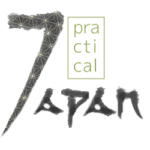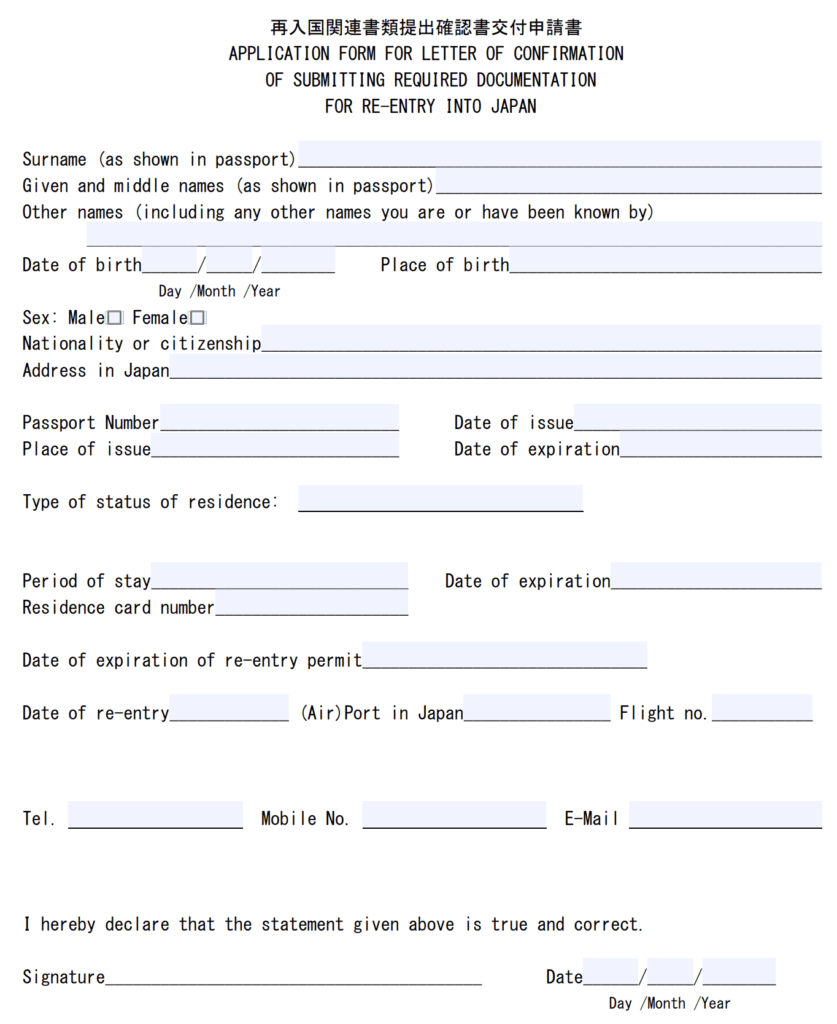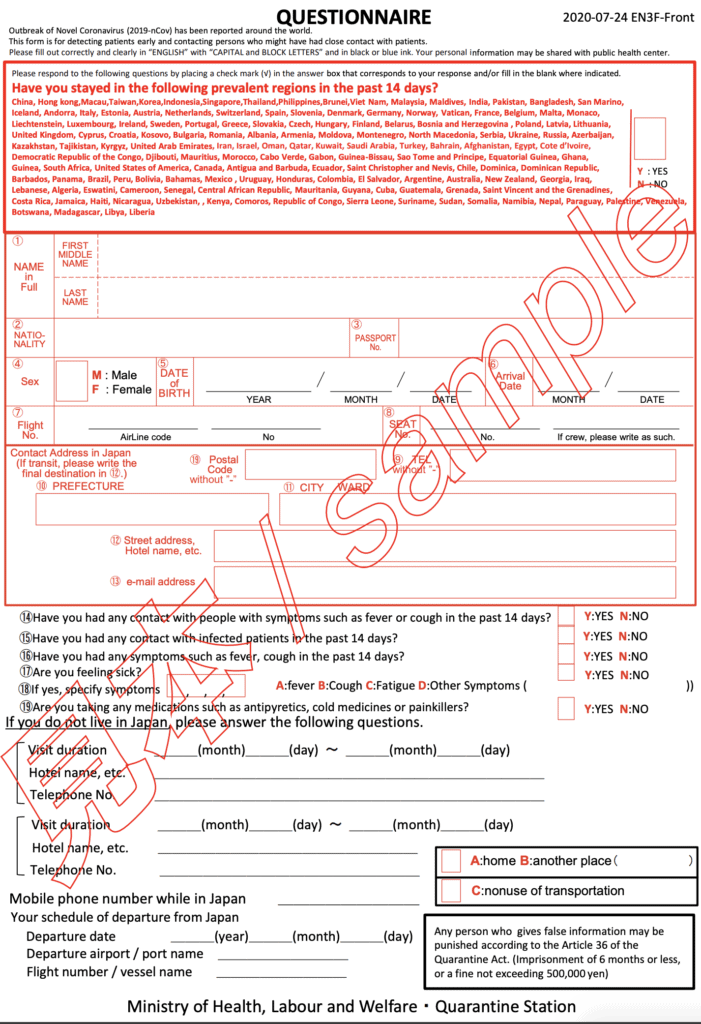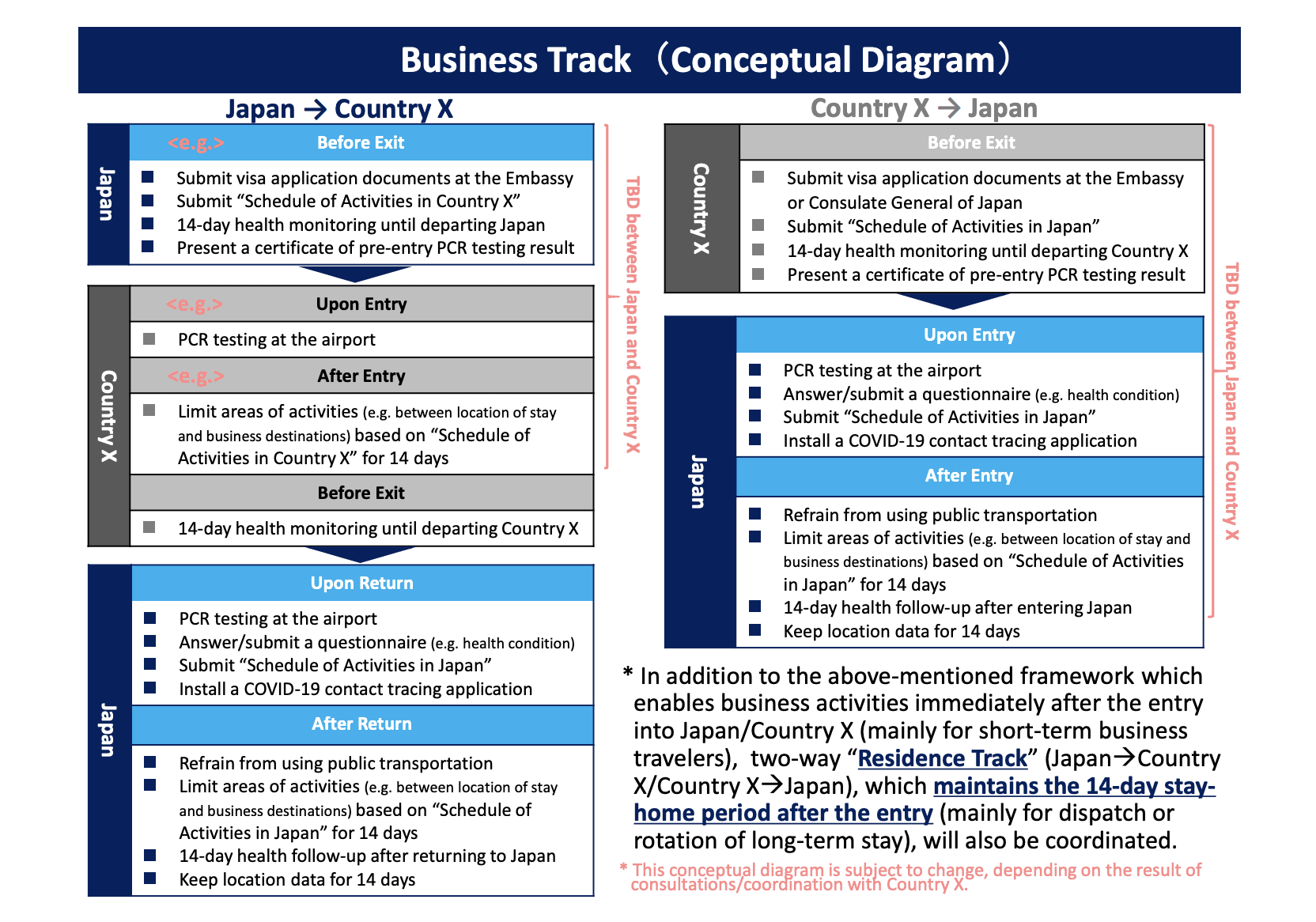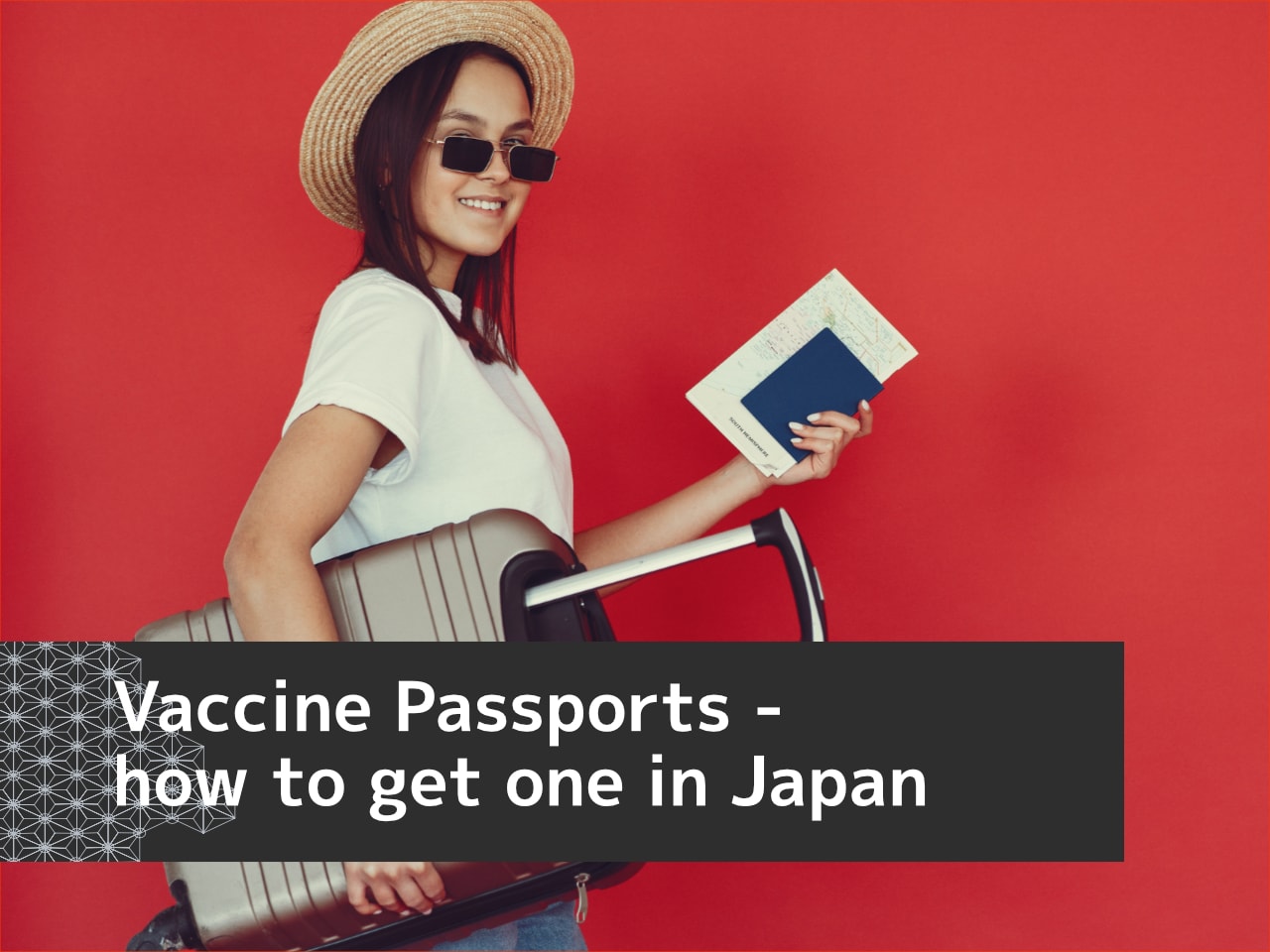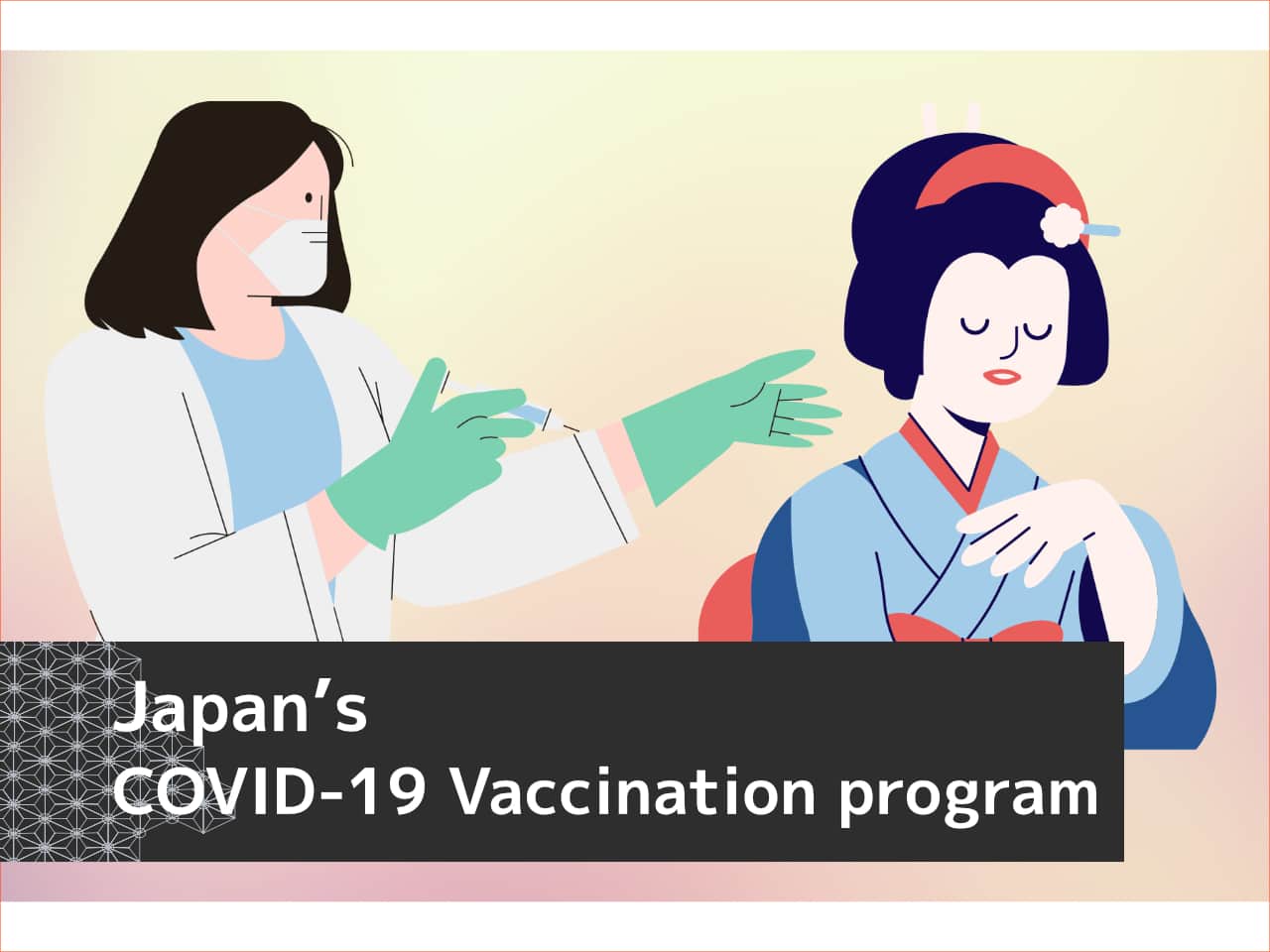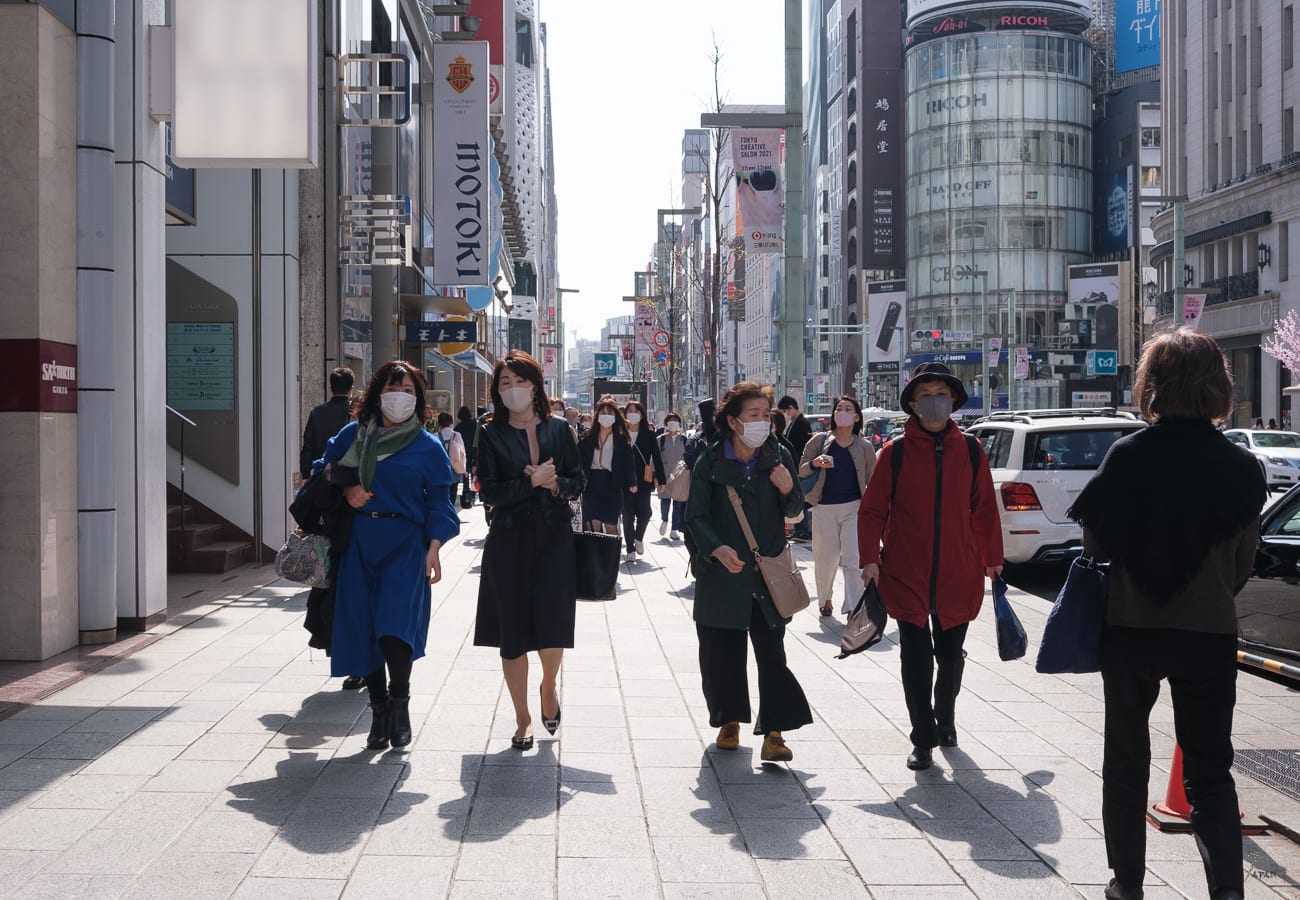
There is some good news for Japanese foreign residents stranded outside the country by the COVID-19 pandemic. Even though foreign tourists still cannot get in, foreigners with a mid- or long-term status of residence are now allowed to re-enter Japan if they fulfil several conditions set out by the government. Read on for an outline of the new regulations and learn if you qualify for re-entry.
2021.1.8 Update: Prime Minister Suga declared a new state of emergency for parts of Japan. For More information on the changes to immigration procedures, refer to my latest post on the subject: COVID-19 in Japan: A Simple Guide to 2021 State of Emergency.
1. Foreigners are (mostly) still not allowed to enter Japan
According to the latest information posted on the Ministry of Foreign Affairs Website, Japan bans citizens of 159 out of 192 countries, as well as people who visited them within 14 days before arriving in Japan, from entering.
The government also suspended the validity of visas issued by March or April 2020 (depending on the location of the issuing embassy or consulate). Visa-free entry is also suspended “for the time being” – you now must apply for a visa if you plan to go to Japan.
Countries on the Japanese landing ban list
Indonesia, Singapore, Thailand, Korea, Taiwan, China (including Hong Kong and Macau), Philippines, Brunei, Vietnam, Malaysia, Australia, New Zealand, Canada, United States, Ecuador, Chile, Dominica, Panama, Brazil, Bolivia, Iceland, Ireland, Albania, Armenia, Andorra, Italy, United Kingdom, Estonia, Austria, Netherlands, Northern Macedonia, Cyprus, Greece, Croatia, Kosovo, San Marino, Switzerland, Sweden, Spain, Slovakia, Slovenia, Serbia, Czech Republic, Denmark, Germany, Norway, Vatican, Hungary, Finland, France, Bulgaria, Belgium, Poland, Bosnia and Herzegovina, Portugal, Malta, Monaco, Moldova, Montenegro,Latvia, Lithuania, Liechtenstein, Romania, Luxembourg, Israel,Iran, Turkey, Bahrain, Egypt, Ivory Coast, Democratic Republic of the Congo, Mauritius, Morocco
Antigua and Barbuda, Saint Kitts and Nevis, Dominican Republic, Barbados, Peru, Ukraine, Belarus, Russia, United Arab Emirates,Oman, Qatar, Kuwait, Saudi Arabia, Djibouti
The Maldives, Uruguay, Colombia, Bahamas, Honduras, Mexico, Azerbaijan, Kazakhstan, Cabo Verde, Gabon, Guinea Bissau, São Tomé and Príncipe, Equatorial Guinea
India,Pakistan, Bangladesh, Argentine, El Salvador, Kyrgyz,Tajikistan, Afghanistan, Ghana,Guinea, South Africa
Guyana, Cuba, Guatemala, Grenada, Costa Rica, Jamaica, Saint Vincent and the Grenadines, Nicaragua, Haiti, Georgia, Iraq,Lebanon, Algeria, Eswatini, Cameroon, Senegal, Central African Republic, Mauritania
Nepal, Suriname, Paraguay, Venezuela, Uzbekistan, Palestine, Kenya, Comoros, Congo, Sierra Leone, the Sudan, Somalia,Namibia, Botswana, Madagascar, Libya, Liberia
Bhutan, Trinidad and Tobago, Belize, Ethiopia, Gambia, Zambia, Zimbabwe, Tunisia, Nigeria, Malawi, South Sudan, Rwanda, Lesotho
2. Who is allowed to re-enter Japan?
Foreign residents may re-enter Japan in the following cases:
1) If the country they visited is not on the landing ban list;
2) In case there are “special exceptional circumstances” (humanitarian grounds, etc.);
3) Foreigners who left Japan before the date the country they are staying in was designated as “an area subject to denial of permission to enter Japan”;
4) Foreigners who departed Japan before August 31 and those who departed after September 1 with a valid re-entry permit if they have the following status of residence:
- Permanent Resident,
- Spouse or Child of Japanese National,
- Spouse or Child of Permanent Resident,
- Long-Term Resident.
5) Business travellers or holders of specific working visas eligible to enter under the “Phased Measures toward Resuming Cross-Border Travel”.
3. What is the re-entry procedure?
Before you can enter Japan under the new rules, you will need to present a couple of documents to the immigration and quarantine officials at the airport:
- “Letter of Confirmation of Submitting Required Documentation for Re-entry into Japan” or a “Receipt for a request of re-entry”
- Certificate of negative COVID-19 test result (test conducted within 72 of departure)
If you cannot submit the two documents on arrival in Japan, you may be denied entry.
The two documents are also required if you plan to return to Japan taking advantage of the “exceptional circumstances” clause.
When you arrive in Japan, you must quarantine for 14 days at a location specified by the authorities and not to use public transport.
How to get the certificate of a negative COVID-19 test result?
You should have the test done at a medical institution within 72h before arriving in Japan. Some airlines will require you to present the negative test result before boarding your flight.
The Ministry of Foreign Affairs website has a form you can print out and have the medical institution fill out for you. If the institution has its own document template it is also acceptable as long as the document is in English and contains at least the following information:
- Your personal information (name, passport number, nationality, date of birth, sex)
- Test method*
- Test result
- Sample type (nasopharyngeal swab or saliva)
- Date and time of sampling
- Date of the test result
- Date of issuance of the certificate
- Information about the medical institution (name and address of the institution or name of a doctor, official stamp or signature)
*Only the following testing methods are accepted:
- Nucleic acid amplification test (real-time RT-PCR)
- Nucleic acid amplification test (LAMP)
- Antigen test (CLEIA)
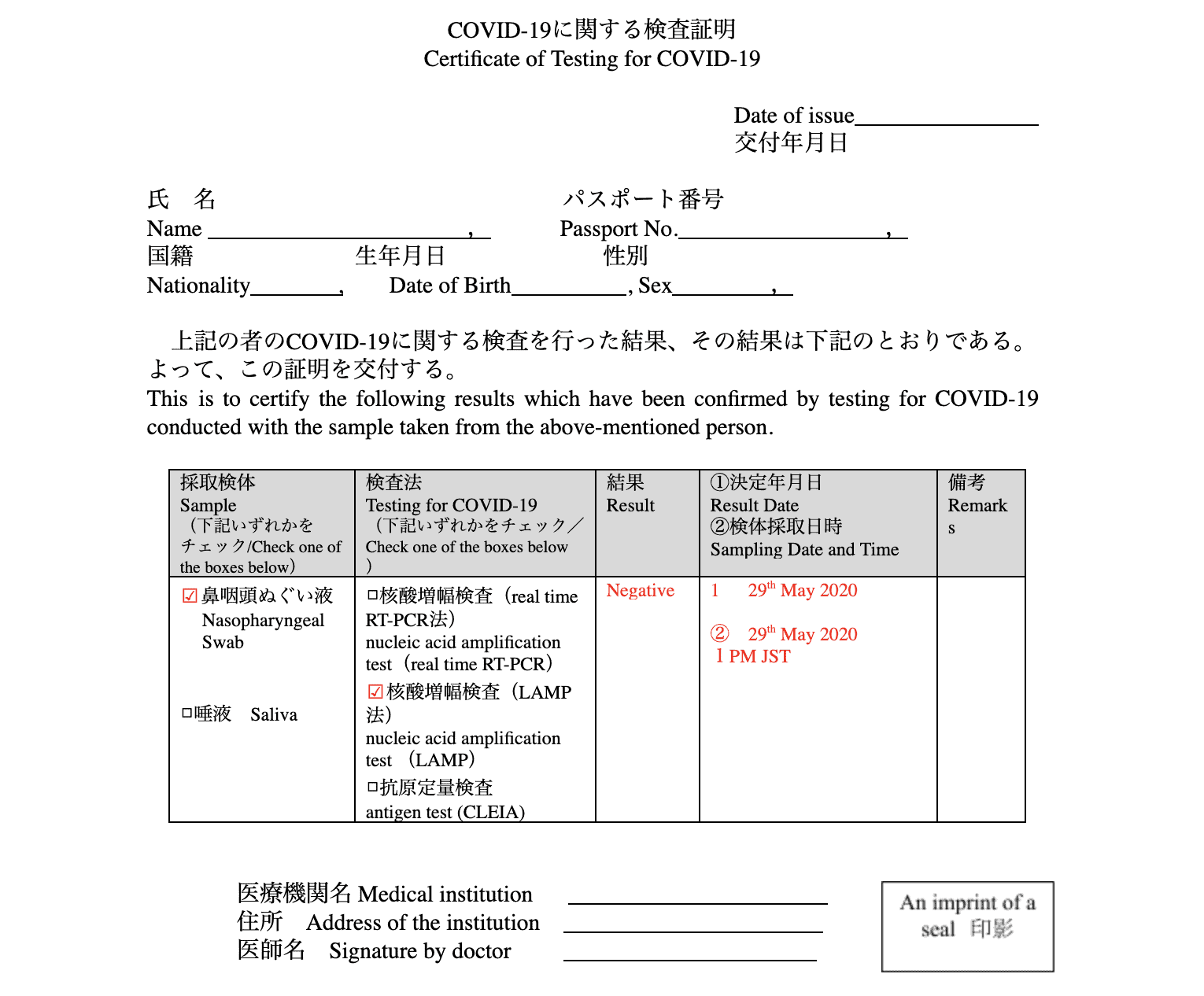
Where to get the COVID-19 test done?
The country you are staying in should have a list of institutions that can conduct a COVID-19 test for purposes of international travel. A good place to look is the country’s foreign minister’s website or the embassy or consulate of Japan.
What if testing for asymptomatic patients is not available in your country? Tough luck – the Japanese government suggests you stop in a third country, do the test, and then try entering Japan.
If you need a COVID-19 test for travel from Japan, the Japanese Society of Travel and Health has prepared a list of medical institutions that conduct COVID-19 tests for travellers intending to depart Japan.
Cases in which entry or re-entry is possible without the COVID-19 test
If you have an urgent need to enter or re-enter Japan and you cannot get a “Certificate of Testing for COVID-19”, you need to inform the diplomatic mission in your country of residence of this fact when you apply for the “Re-entry Confirmation Letter”. You will also need to submit documents to explain the urgency.
Some cases in which entry or re-entry is possible without the COVID-19 test are:
- You need to go to Japan for medical treatment (you need to provide a medical certificate that proves the urgency).
- You need to go to Japan to visit a relative who is in critical condition or to attend a funeral of ar relative (you need to provide a medical certificate that the relative is in a critical condition or a death certificate and documents proving your relationship.
For more information, contact the Adjudication Division, Immigration Department, Immigration Services Agency Tel: (Operator) 03-3580-4111 (Ext. No. 4446・4447).
Where to get the "Letter of Confirmation of Submitting Required Documentation for Re-entry into Japan"?
The application for the “Letter of Confirmation of Submitting Required Documentation for Re-entry into Japan” (“Re-entry Confirmation Letter”) is free. Apply at your local Japanese embassy or consulate. Depending on how busy your local Japanese consulate or embassy is, you may have to wait a couple of days before you can pick up your document.
You will need to present the following documents:
- A passport with a valid re-entry permit,
- A residence card issued by the Japanese government,
- Application Form for the “Letter of Confirmation of Submitting Required Documentation for Re-entry into Japan”.
The application form contains your personal information (name, date and place of birth, phone number, email address, sex, nationality), information about your passport and residence card, your address in Japan, and your planned re-entry date, flight number and destination airport.
How to get a "Receipt for a request of re-entry"?
If you plan to leave Japan temporarily after September 1, apply for a “Receipt for a request of re-entry” from the Immigration Services Agency of Japan BEFORE YOU LEAVE. You can make the request from about 1 month before your scheduled departure.
You will need to keep the Receipt and present it again when you re-enter Japan (this document is a substitute for the “Re-entry Confirmation Letter, so you don’t need both”).
The receipt is valid only for one person and one specific re-entry, so if you are planning to go with your family, make sure you send an email for each member of your party.
If your itinerary changes after you have emailed the Agency, you will not have to re-send the request if the departure date changed by less than 1 month. Just let the immigration officer at your port of departure/re-entry know.
If you have questions about the procedure, contact the Border Management Division, Immigration Department, Immigration Services Agency Tel: (Operator) 03-3580-4111 (Ext. No. 5686・2760)

Application process for "Receipt for a request of re-entry"
1) Send an email with the subject “再入国予定の申出について” to one of the following addresses:
- For residents of the Tokyo Metropolitan area, Kanagawa Prefecture, Saitama Prefecture, Chiba Prefecture, Ibaraki Prefecture, Tochigi Prefecture, Gunma Prefecture, Yamanashi Prefecture, Nagano Prefecture or Niigata Prefecture: reentry-confirmation-req01.immi@i.moj.go.jp
- For residents of areas other than those listed above reentry-confirmation-req02.immi@i.moj.go.jp
The email should contain at least the following:
- Pledge to conform to the additional quarantine measures (to get a COVID-19 test result within 72h of departure for Japan)
- Your personal information (name, date of birth, nationality, residence card number)
- Your travel itinerary (destination, departure date, departure port, re-entry date and re-entry port)
2) Receive a confirmation email from the Immigration Services Agency of Japan – save the email or print it out. (usually takes a few days)
3) Present the Receipt at your port of departure to an immigration officer.
What are the quarantine rules after re-entering Japan?
COVID-19 test on arrival in Japan
If you have visited countries from the landing ban list within 14 days of entering Japan, you will undergo a COVID-19 test after you arrive in Japan. Be prepared for a stay at the airport or a designated facility until you receive the results (usually about 1-3h, longer if you need to be re-tested). When you get the results, you can proceed through immigration.
14-day self-isolation after you re-enter Japan
After arriving in Japan, register your intended self-isolation location and the means of transportation from the airport with the quarantine officer. You must stay at your home, a company dormitory, home of a relative or friend, monthly mansion or hotel or other location designated by the Chief of the Quarantine Station for 14 days counting from the day after your arrival. The location should have a separate toilet and bath you can use.
You may not use public transport (trains, buses, taxis, domestic flights), so you will need to arrange for someone to pick you up from the airport or get a rental car (here is a list of rental car companies provided by the Ministry of Health, Labour and Welfare). If you can’t arrange a private car or drive a rental car, your only choice would be to rent a room at a hotel near the airport.
During the 14 days, must not leave the designated location and should avoid contact with other people as much as possible.
Additional quarantine measures during self-isolation
If you have visited one of the countries on the landing ban list within 14 days before you arrive in Japan, the local Health Center will expect you to report on your health condition by phone or through email every day. You can also opt to use LINE – there is a field for that on the Questionnaire you will fill out at arrival.
In addition, the Ministry of Health, Labour, and Welfare encourages all people who enter Japan to install the contact tracing app COCOA and keep their location history on the map application of their choice for 14 days
4. In what cases can I re-enter Japan based on the “special exceptional circumstances” rule?
The Government of Japan may grant special permission to foreigners who departed Japan with a re-entry permit or have the status of residence of Permanent Resident, Spouse or Child of Japanese National, Spouse or Child of Permanent Resident or Long-Term Resident if there are “special exceptional circumstances”.
Whether you will be allowed to enter Japan depends both on the reason for your departure/re-entry and on the timing.
If you need more information, contact the Adjudication Division, Immigration Department, Immigration Services Agency Tel: (Operator) 03-3580-4111 (Ext. No. 2796)
If you departed BEFORE your destination was put on the landing ban list
Those who departed Japan before the country they left for was put on the denial of landing list:
- You have been separated from your family who is in Japan,
- You have departed Japan with your child who is enrolled in a Japanese school and needs to return to continue their education,
- You need to receive medical treatment in Japan (surgery, childbirth, etc.),
- You departed Japan to visit a relative in critical condition abroad or to attend a funeral of a relative,
- You departed Japan to receive medical treatment at a medical institution abroad (surgery, childbirth, etc.),
- You have received a summons from a foreign court to appear as a witness,
- You have the status of Instructor or Professor and need to re-enter Japan to fill a vacancy at the educational institution you belong to (if the vacancy results in suspension of the educational activities at the institution),
- You have the residence status of Medical Services.
If you departed AFTER your destination was put on the landing ban list
Those who departed Japan after the country they left for was put on the denial of landing list:
- You departed Japan to visit a relative in critical condition abroad or to attend a funeral of a relative,
- You departed Japan to receive medical treatment at a medical institution abroad (surgery, childbirth, etc.),
- You have received a summons from a foreign court to appear as a witness.
5. Who can enter and re-enter Japan as part of the “Phased Measures toward Resuming Cross-Border Travel”?
On June 18, 2020, the Japanese Government introduced special measures to ease travel restrictions for business travellers and holders on specific working visas on a trial basis. Currently, the measures apply to foreigners from Thailand, Viet Nam, Malaysia, Cambodia, Laos, Myanmar and Taiwan, but the scope will be extended to other countries when negotiations are completed.
There are two systems, the “Business Track” and the “Residence Track”.
- Business Track: short-term business travellers may enter Japan and conduct limited business activities during the 14-day stay at home period.
- Residence Track: long-term residents who need to enter Japan for work are allowed in but need to stay at home or another designated location for 14 days.
What sort of visas are accepted under this program?
The following visa holders are eligible to take part in the “Phased Measures toward Resuming Cross-Border Travel” program:
- Short-term stay for business
- Work or long-term stay with one of the following statuses of residence:
- Business manager,
- Intra-company transfer,
- Engineer / Specialist in humanities / International services,
- Nursing care,
- Highly skilled professional,
- Technical Intern Training,
- Specified Skilled Worker,
- Designated activities (Start-up)
Additional quarantine measures for Business and Residence Track travellers to Japan
Foreigners who enter Japan under this program will have to adhere to additional quarantine measures:
- Get a “Written Pledge” (a document stating their receiving organization’s commitment to implementing the quarantine measures) and the “Schedule of Activities in Japan” (contains intended residence address, business destinations and persons the foreigner wishes to contact in Japan, for Business Track only) from their receiving organization.
- Monitor their health for 14 days before departure (daily temperature checks, monitoring for symptoms of COVID-19) and write the results on the Questionnaire distributed on the plane (if the traveller has symptoms, they will have to cancel their trip).
- Submit the Re-entry Confirmation Letter and the negative COVID-19 test result.
- Take out private medical insurance before entering Japan or register with the public insurance system in Japan (company health insurance, National Health Insurance).
- Spend 14 days in quarantine after arriving in Japan (in some cases this does not apply to the Business Track visitors).
- Install the COVID-19 contact tracing application COCOA.
- Install LINE application and take part in 14-day “health follow-up” after they enter Japan (this involves sending daily reports of their health condition through LINE). This can be done by the traveller directly or by a representative of the receiving entity.
- Keep location data for 14 days after entering Japan using a map application (such as Google Map).
Downloads
- Certificate of Testing for COVID-19 – Ministry of Foreign Affairs of Japan (MOFA)
- Application form for Re-entry Confirmation Letter – MOFA
- COVID-19 contact tracing application (COCOA)
- Written Pledge for the Residence Track under the “Phased Measures toward Resuming Cross-Border Travel” – MOFA
- Schedule of Activities in Japan – MOFA
- List of Japan visa information hotlines – MOFA
- List of rental car companies prepared by the Ministry of Health, Labour and Welfare (in Japanese, individual companies may have English websites)
- Example of the Questionnaire you will fill out at arrival – MHLW
Useful links
- Border enforcement measures to prevent the spread of novel coronavirus (COVID-19) – MOFA (2020/8/30)
- Entry and Re-entry of Foreign Nationals with Special Exceptional Circumstances – MOFA (2020/8/6)
- Cases where permission for re-entry may be granted due to special exceptional circumstances – Ministry of Health, Labour and Welfare (MHLW) (2020/6/12)
- Re-entry of foreign nationals with the status of residence – MOFA (2020/8/28)
- Application for Visa or Letter of Confirmation of Submitting Required Documentation for Re-entry into Japan for foreign nationals eligible for Phased Measures toward Resuming Cross-Border Travel – MOFA (2020/9/4)
- Phased Measures toward Resuming Cross-Border Travel – MOFA (2020/9/4)
- Phased Measures for Resuming Cross-Border Travel – MOFA (2020/8/24)
- Process and Required Documents for Re-entry – MOFA (2020/8/13)
- Regarding refusal of landing to prevent the spread of COVID-19 (novel Coronavirus) – Ministry of Justice (MOJ) (2020/8/28)
- Additional Epidemic Prevention and Control Measures for the Entry or Re-entry of Foreign Nationals – MOJ (2020/8/21)
- COCOA (COVID-19 Contact-Confirming Application) Contact tracing application of the Japanese Government -MHLW
- List of medical institutions in Japan that conduct COVID-19 tests for business travellers – JSTH Japanese Society of Travel and Health
- Q&A on COVID-19 prevention measures – MHLW (2020/3/26)
- 水際対策の抜本的強化に関するQ&A – MHLW
- Notice from the Quarantine Station to Persons Entering Japan – MHLW (2020/7/24)
- FAQ on re-entry procedures for foreigners who depart Japan after September 1, 2020 – MOJ
- Request of intention to re-enter Japan for foreign nationals with status of residence currently residing in Japan – MOJ (2020/9/3)
Disclaimer
Please share
If you have found information in this post useful or interesting, please like it or share it on social media. Thanks!


MARTA TAKAHASHI
Photographer and explorer with over 10 years of experience living and working in Japan
